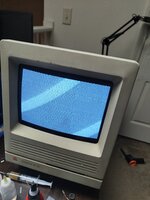Tl;Dr I need to know the bare minimum that needs to be populated on a SE/30 logic board for it to boot. I don't need it to be able to do anything except show me a question mark.
Hello everyone. I apologize for what surely will be a huge lack of etiquette on my part. It's been 10+ years since I have posted on here. I have a SE/30 that had bad caps. The LB was in working order prior to the recap, but after I was met with simasimac. The corrosion was not nearly as significant as I have seen on some, but I figured there must be damage under the surface. I did some troubleshooting with the old board but never got anything definitive. Eventually I came across Bolle's project and ordered some replacement logic boards. I fully populated the new board and am now met with the exact same thing. For the new board I used as many new components as possible. I even have tried a new set of GAL (I think GAL anyway) chips programmed from the files on Bolle's GitHub repository. Still no dice. I have replaced all of the UX8 chips as well. 166 and 253s and whatnot. Still simasimac. I have checked a ton of traces as well at this point. All of the ones from the glue, CPU and I believe UH7. The 20 pin PLCC. This one I have not replaced yet. I have tried multiple ROMS and RAM combinations to no avail. I have now started removing some chips and transferring parts back and forth. The new board now has the original oscillator crystals. Still nothing. No change whatsoever.
So, any help or suggestions anyone could give would be highly appreciated. I have diagnostic tools (Oscope, multimeter, but no logic probe). Here's hoping withe the community's help we can save one more 030 from the grave.
Hello everyone. I apologize for what surely will be a huge lack of etiquette on my part. It's been 10+ years since I have posted on here. I have a SE/30 that had bad caps. The LB was in working order prior to the recap, but after I was met with simasimac. The corrosion was not nearly as significant as I have seen on some, but I figured there must be damage under the surface. I did some troubleshooting with the old board but never got anything definitive. Eventually I came across Bolle's project and ordered some replacement logic boards. I fully populated the new board and am now met with the exact same thing. For the new board I used as many new components as possible. I even have tried a new set of GAL (I think GAL anyway) chips programmed from the files on Bolle's GitHub repository. Still no dice. I have replaced all of the UX8 chips as well. 166 and 253s and whatnot. Still simasimac. I have checked a ton of traces as well at this point. All of the ones from the glue, CPU and I believe UH7. The 20 pin PLCC. This one I have not replaced yet. I have tried multiple ROMS and RAM combinations to no avail. I have now started removing some chips and transferring parts back and forth. The new board now has the original oscillator crystals. Still nothing. No change whatsoever.
So, any help or suggestions anyone could give would be highly appreciated. I have diagnostic tools (Oscope, multimeter, but no logic probe). Here's hoping withe the community's help we can save one more 030 from the grave.


